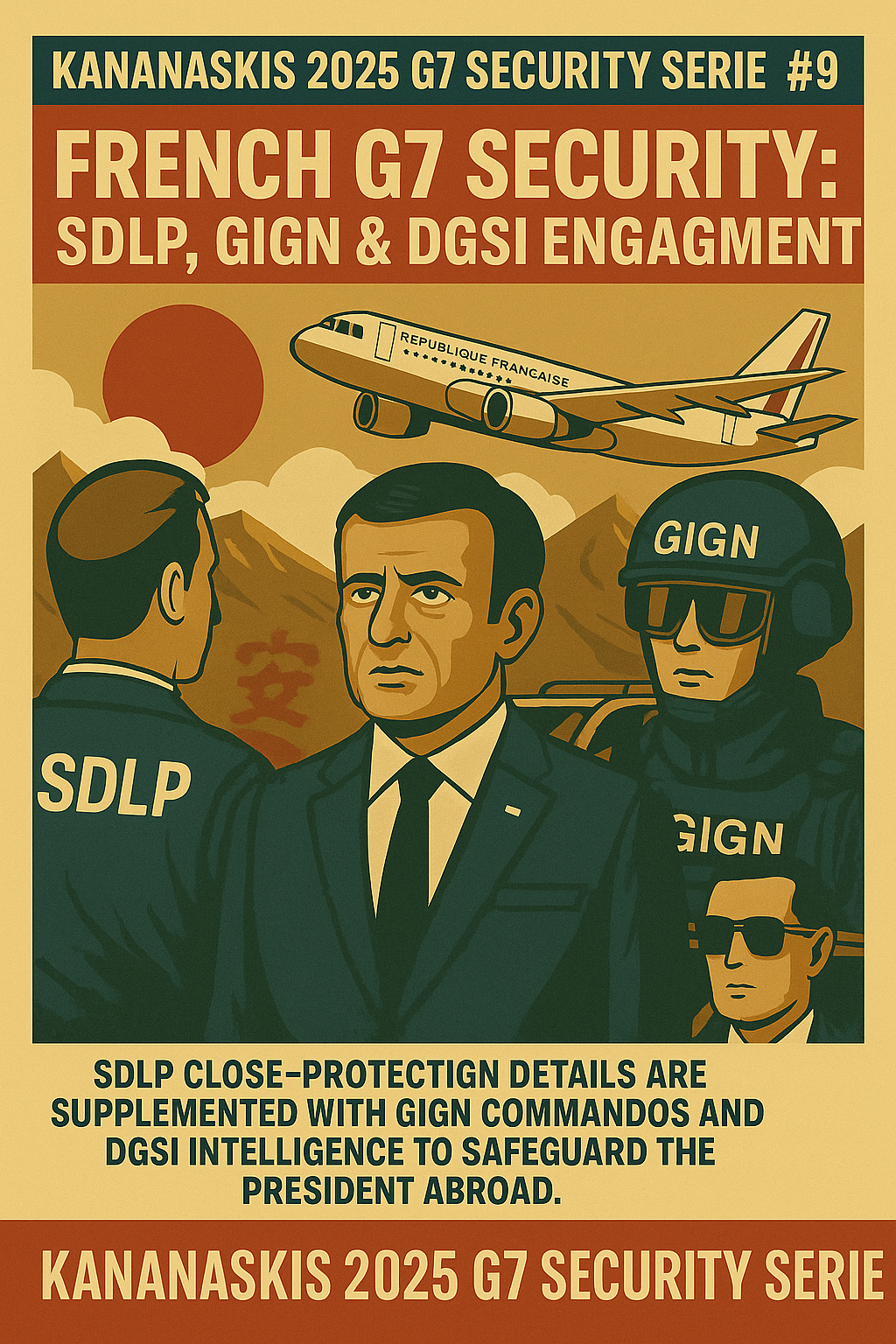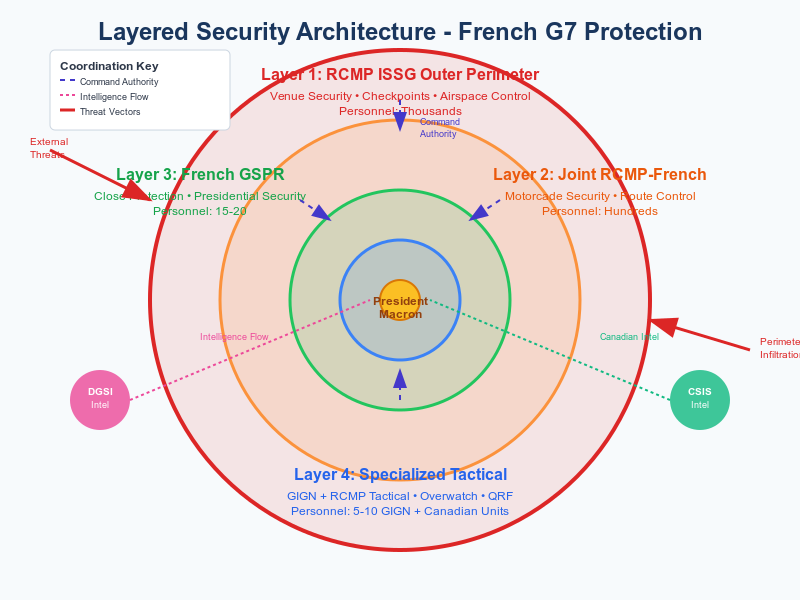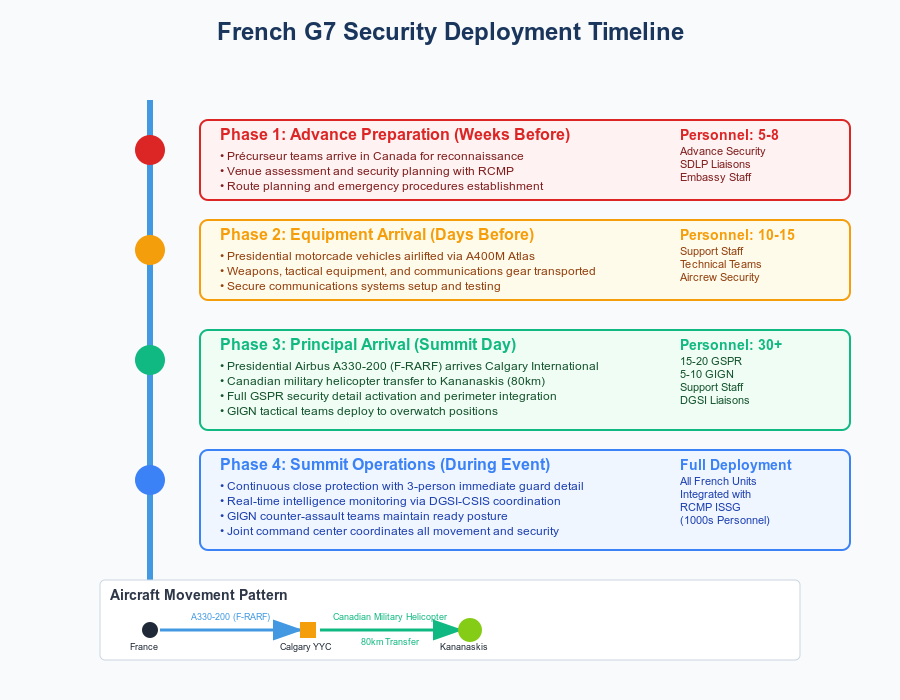Address
304 North Cardinal St.
Dorchester Center, MA 02124
Work Hours
Monday to Friday: 7AM - 7PM
Weekend: 10AM - 5PM

France’s delegation to the 2025 G7 Leaders’ Summit in Kananaskis, Alberta is supported by a multi-layered security team. Key components include the Service de la Protection (SDLP) – which provides the President’s close protection detail (GSPR) – augmented by operators from the elite GIGN (Gendarmerie’s intervention group) for specialized tactical support. Internal security and intelligence personnel (from DGSI, the domestic security agency) are also involved, working via the French Embassy to liaise with Canadian authorities on counter-intelligence and threat assessments. All protective efforts are closely coordinated with the host nation’s security framework, led by the RCMP’s Integrated Safety and Security Group (ISSG), to ensure deconfliction and a unified protective posture.

The French President’s security entourage typically includes a GSPR close-protection team of around several dozen officers drawn from both the National Police (SDLP) and Gendarmerie (GIGN). For high-level summits, a special GIGN contingent within GSPR is deployed to bolster protection – these are members of GIGN’s Force Sécurité Protection (FSP), a 65-operator unit specializing in executive security and sensitive site protection. This means French GIGN commandos work alongside SDLP bodyguards to protect President Emmanuel Macron at all times, even overseas. The GIGN personnel in the detail bring military-grade expertise (many are parachute-trained and veterans of counter-terror operations) to reinforce the close protection mission.
In a summit scenario, GIGN operators often include sniper/marksman teams and tactical officers equipped for hostage-rescue or quick extraction of the principal if needed. GIGN’s training encompasses sniper proficiency, covert surveillance, breaching and fast-rope helicopter insertion. It is public record that GIGN’s Security & Protection teams drill on helicopter extraction scenarios for VIP rescue. At Kananaskis – a remote, forested venue – French sniper teams could be positioned (with host permission) to overwatch the immediate vicinity of the President, augmenting Canadian sniper units. Similarly, small counter-assault teams of GIGN could stand ready as a quick reaction force. These operators would integrate into the French motorcade or air transport detail to provide tactical support in the event of an attack, while primary emergency response (SWAT, military) is handled by Canada. Such measures are precautionary; they were also seen at France’s own G7 in 2019, where RAID and GIGN units were on alert to respond to any serious incident.

All foreign protective details must closely coordinate with the RCMP-led ISSG to avoid friendly-fire or jurisdictional conflicts. French security leaders participate in advance liaison with Canadian authorities – for example, French “précurseur” teams (advance security scouts) typically arrive weeks in advance to work with local police on venue security and motorcade routes. At the summit itself, the French team operates under RCMP overall authority for venue security, but retains responsibility for immediate protection of the French President. Deconfliction protocols ensure that French snipers or armed agents are known to the ISSG command center. Communication links are established so that, in an emergency, GIGN and RCMP tactical units can coordinate their response. This integration is standard practice – for instance, during the Biarritz G7 (2019) in France, SDLP officers liaised with visiting countries’ security teams, and by the same token in Canada the visiting French team liaises through designated RCMP security liaisons.
The Service de la Protection (SDLP), a branch of the National Police, has primary charge of close protection for French dignitaries. Within SDLP, the Groupe de Sécurité de la Présidence de la République (GSPR) is the Presidential Security Group. The GSPR is a mixed unit of roughly 70–80 personnel split between police officers and GIGN gendarmes. This team travels with the President on all official trips. At the G7 summit, GSPR agents will form the innermost security ring around President Macron – escorting him at the venue, in transit, and at any public appearances. According to French officials, about three GSPR bodyguards stay in immediate proximity whenever the President is in a crowd or engaging with the public. Others handle motorcade driving, formation positions, and command post duties. The GSPR works hand-in-glove with RCMP personal protection officers assigned to the French delegation, sharing movement schedules and secure comms. Notably, SDLP officers maintain constant contact with foreign counterparts during summits, ensuring the French President’s route and venues are secured by Canadian outer perimeters while French bodyguards cover close-in threats.
Alongside the visible bodyguards, France deploys protective intelligence personnel to a summit. The DGSI (Direction Générale de la Sécurité Intérieure) – France’s domestic intelligence service – plays a role in counter-intelligence and counter-terrorism for French interests, even abroad. For major events, DGSI analysts and liaisons likely embed with the delegation or at the French Embassy in Ottawa to monitor threats specific to French nationals or interests. One focus is identifying any French extremist or protest groups that might target the summit. (During the 2019 G7 in France, French intelligence tracked thousands of potential violent protesters, including anarchists and Basque extremists). In the Canadian context, DGSI would coordinate with Canada’s CSIS and the Integrated Terrorism Assessment Centre to share information on threats. Additionally, France’s Interior Security Attaché at the embassy (a senior liaison officer from the Police or Gendarmerie) facilitates real-time intel sharing and law enforcement cooperation. This ensures any counter-espionage concerns (e.g. foreign spies targeting the French delegation) or cybersecurity issues are relayed to the host for action. While much of DGSI’s work is behind the scenes, it’s a critical layer to detect and preempt threats, enabling the physical protection teams (SDLP/GIGN) to focus on immediate security.
President Macron will arrive in Canada aboard the French Presidential Airbus A330-200 (tail number F-RARF), the long-range VIP aircraft operated by the French Air Force. This jet serves as France’s version of “Air Force One,” and typically flies the President plus core staff and close protection officers directly to major events. For the Kananaskis summit, the A330 carrying the President and delegation will land at Calgary International Airport ahead of the summit opening. In addition, France usually arranges secondary airlift for equipment and support personnel: this could include an Air Force A400M Atlas transport or chartered cargo aircraft to ferry the presidential motorcade vehicles, weapons, and other logistics. It is common for world leaders to bring an armored state car and escort vehicles to high-security summits – these are often flown in days prior. For example, the United States routinely airlifts its presidential limousines to such events; France’s delegation is smaller but may still ship a primary armored sedan/SUV for the President’s use, along with possibly a back-up vehicle and some tactical gear. These would be offloaded in Canada (either in Calgary or at a military airfield) under RCMP security oversight, then pre-positioned for the President’s arrival.
The French presidential motorcade in Canada will be a joint endeavor. It likely includes the French-supplied armored presidential car (President Macron often uses a custom armored Peugeot/DS or similar), escorted by RCMP vehicles and police motorcycle outriders. Within the motorcade, multiple vehicles carry French security: an SUV or van with GIGN tactical agents, another with additional SDLP bodyguards, and possibly a communications/medical support vehicle. Canadian authorities typically provide marked police cruisers to lead and trail the convoy, and an ambulance on standby. While in a foreign country, French security personnel generally do not engage in high-speed driving themselves on public roads unless necessary – RCMP drivers familiar with local routes may pilot some escort vehicles. However, the French President’s own car is often driven by a trained French security chauffeur. All route planning and traffic control is handled by the RCMP and local police (in this case, Calgary Police and Alberta Sheriffs as part of ISSG). Motorcade movements are tightly timed and often conducted as rolling closures to minimize disruption. For the remote Kananaskis location, air transfers are favored: indeed, during the 2002 G8 Summit at the same site, leaders were flown in individually by helicopter from Calgary to Kananaskis. We expect a similar approach in 2025 – President Macron and his team will likely board Canadian military helicopters for the roughly 80 km journey into the secured summit venue, avoiding a long motorcade through mountain highways. The French motorcade vehicles would then be used mainly for any ground movement within the secure zone or for contingency plans if helicopters cannot fly.
Once on the ground at the venue, the French protective detail operates under a doctrine of layered security in the host country. The RCMP-led ISSG maintains the outer cordon (e.g. checkpoints, venue perimeter, airspace restrictions), allowing French security to concentrate on the immediate circle around the President. Whenever the President moves (even a short distance on foot), French GSPR agents form a close bodyguard ring, with GIGN marksmen and RCMP tactical teams posted at overwatch positions. All French vehicles in the motorcade are inspected and accredited by Canadian security, and any French personnel armed with firearms are documented and typically accompany the principal or remain at delegation premises (such as hotel or residence security posts). Host-nation police vehicles lead the route, while French security cars stay immediately around the principal’s car. This doctrine ensures that the host country’s protocols (road closures, piloting, emergency response) are followed, while the visitor’s team can fulfill its protective mission under agreed rules. French drivers and guards remain in constant radio contact with RCMP motorcade control to handle any incident en route. In Calgary, if President Macron engages in any public events or bilateral meetings, the motorcade will be employed to transport him under RCMP escort, using pre-cleared routes with heavy police presence (a standard protective motorcade procedure in Canada’s major cities).

All members of the French President’s security detail enter Canada as part of the official delegation, which grants them certain diplomatic privileges. During the G7 Summit period, foreign representatives (including security personnel serving in an official capacity) are accorded immunities comparable to those of diplomatic agents. Practically, this means French security officers have protection from local jurisdiction to perform their duties – they cannot be easily arrested or impeded while protecting their Head of State. However, carrying firearms on foreign soil is not automatically permitted by diplomatic immunity; it is strictly governed by host nation consent. Canada generally authorizes a limited number of foreign bodyguards to be armed, under confidential arrangements for events of this stature. The RCMP, as lead agency for VIP protection in Canada, approves and liaises on this matter: foreign security officers must be identified, and their weapons (usually handguns) are declared upon entry. These personnel typically receive a form of temporary peace officer status or a special exemption to Canadian firearms laws for the duration of the summit. (Notably, the RCMP is explicitly responsible for the protection of visiting heads of state on Canadian soil, so any use of force by a foreign agent would be closely coordinated and fall under the RCMP’s overall security mandate.) In essence, French officers are armed for close protection with Canada’s blessing, and both sides share rules of engagement to prevent misunderstandings. All armed French team members will carry summit accreditation badges and communication links to RCMP command, ensuring that Canadian police are aware of who and where the armed agents are at all times. This avoids scenarios observed in other countries’ summits where foreign security could run afoul of local police; Canada’s summit protocols are designed to integrate these teams smoothly.
In the lead-up to and during the G7, there is intensive intelligence sharing between France and Canada (as well as the other G7 partners). Threat assessments for the event are jointly developed – Canada’s ITAC (Integrated Terrorism Assessment Centre) compiles inputs from allied agencies. French intelligence (DGSI and possibly the external service DGSE) provides information on any France-originating threats, such as extremist travelers or plots that might target the French delegation. At the French Embassy in Ottawa, the Interior Security Attaché (a French official from the Ministry of Interior) acts as a hub for this exchange, coordinating with the RCMP, CSIS, and local officials. For example, if DGSI has identified individuals in France who plan to protest or disrupt the summit, that information is passed to Canadian authorities for monitoring at ports of entry. Conversely, Canada shares any specific threat against President Macron or the French delegation. Summit security also involves daily multinational intel briefings – French security attachés and DGSI reps will attend classified meetings with the host’s intelligence center to review the latest threat picture. This covers everything from terrorism and organized crime threats to cyber warnings (e.g. attempts to hack delegates’ communications). The French delegation likely brings its own communications security team to set up encrypted phones and protect against eavesdropping, in coordination with Canadian signals security. In terms of counter-intelligence, DGSI to some extent monitors any activities by hostile states (or other G7 attendees) directed at the French delegation. All these efforts are within OSINT norms, as various summit after-action reports have noted the high degree of cooperation among allied security services for leader protection.
France’s approach at Kananaskis 2025 is consistent with its past protective deployments at international summits and state visits abroad:
Based on open-source precedents, the French protective mission at G7 Kananaskis is likely on the order of a few dozen personnel. This may include roughly 15–20 GSPR close-protection officers (in shifts), about 5–10 GIGN specialists (snipers, tactical support), and a handful of DGSI or liaison officers for intelligence and logistics. Additionally, an aircrew and support staff for the presidential aircraft (pilots, mechanics, communications technicians) accompany the delegation, though they stay with the plane at base. Some French Foreign Ministry security staff could also be present to secure delegation facilities. These numbers are small compared to the overall Canadian security presence (the RCMP and partners are deploying thousands for the summit), but they are force-multiplied by integration into the host’s system. The French team’s priority is protecting the head of state and key dignitaries of France’s delegation; Canadian authorities handle crowd control, outer perimeter defense, and general venue security. In summary, France’s diplomatic security posture at the 2025 G7 is a tightly coordinated, tactical-technical operation that leverages elite French units within the framework provided by Canada. This ensures President Macron and the French delegation remain safe from the time they arrive in Calgary through the summit’s conclusion, complementing Canada’s domestic security effort with France’s own rigorous protective measures.